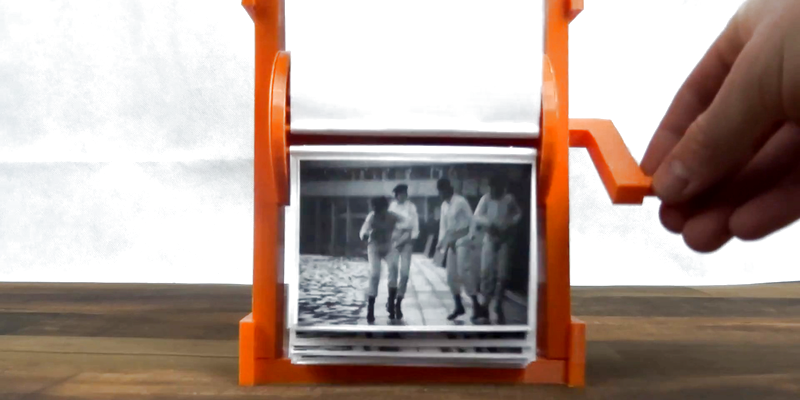[John] got his hands on a 3D printer, and did what any hacker with a new toy would, printed himself a Mutoscope. (A what?) A Mutoscope is an early flip-book based motion picture machine, and in this case it displays 24 frames from “A Clockwork Orange”. [John]’s 3D-printed machine is, not coincidentally we assume, printed in orange plastic.
The model for the frame is up on Thingiverse, but there’s not all that much to it, honestly. It’s a frame and a few wheels that hold some skewers in place. The rest of the work is making the flaps.
But getting to the end product wasn’t a straight walk. [John] describes all of the starts and stops in his blog, aptly named “Fail Try Again”. We like seeing the whole process rather than just the final, seventh, iteration of the device.
Where to take this project next? We want to see a design with a mounting bracket for a cheap stepper motor built in. We’ve always wanted our own custom signage, and there’s nothing cooler than the flap-flap-flap noise that flip book pages make when being switched. We must not be alone in thinking so, because we’ve seen two beautiful DIY builds in the last two years: this one done in multiples for advertising purposes and this one done just for the lulz. [John]’s project is a lot simpler, and thus a lot more accessible. We hope it inspires a few of you to make your own.















Next: print an escapement mechanism to turn the wheel.
There’s clocks were the digits flap down with the changes.
Hi I was wondering if anyone could help me what is the best software to download to make my CNC machine work it’s a Chinese one
LaserWeb : https://hackaday.com/tag/laserweb/
Perhaps [John] was flipped out on droogs when he created this!
It just needs some 3d printed eyelid restraints to force you to watch it over and over.
https://upload.wikimedia.org/wikipedia/en/9/94/Clockwork%2771.jpg
“To fix the issue, the wheels needed an enclosed end, rather than a hole all the way through.
The issue is printing this. If it is printed up one way, it needs supports under most of the wheel, if it is printed up the other way, I would need supports in every spoke hole.”
Can someone explain this?
The first part, is it needed to be enclosed. So the frame holder “spokes” wouldn’t slide all the way through each end and get jammed up on the side posts.
The issue with printing is you can’t print in the air. So it needs supports under it in the places that would be up off the build plate. If I flipped it one way, it would put supports under most of the wheel. If it was the other way then each hole would have supports in it. Given the size of the holes it would have probably printed fine without supports, but I didn’t want any uneven bits inside the holes that the frame spokes could get jammed up on it.
Thats where printing a separate “washer” came in.
There are two screenshots of what it would have looked like printing up each way.
http://i1.wp.com/failtryagain.jcroucher.com/wp-content/uploads/sites/3/2016/10/Screen-Shot-2016-10-28-at-4.43.43-PM.png?resize=768%2C533
http://i2.wp.com/failtryagain.jcroucher.com/wp-content/uploads/sites/3/2016/10/Screen-Shot-2016-10-28-at-4.46.22-PM.png?resize=768%2C577
Thank you mate!
mechanical gif